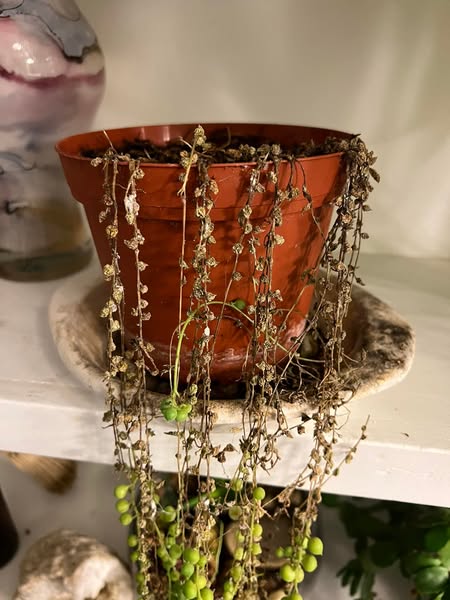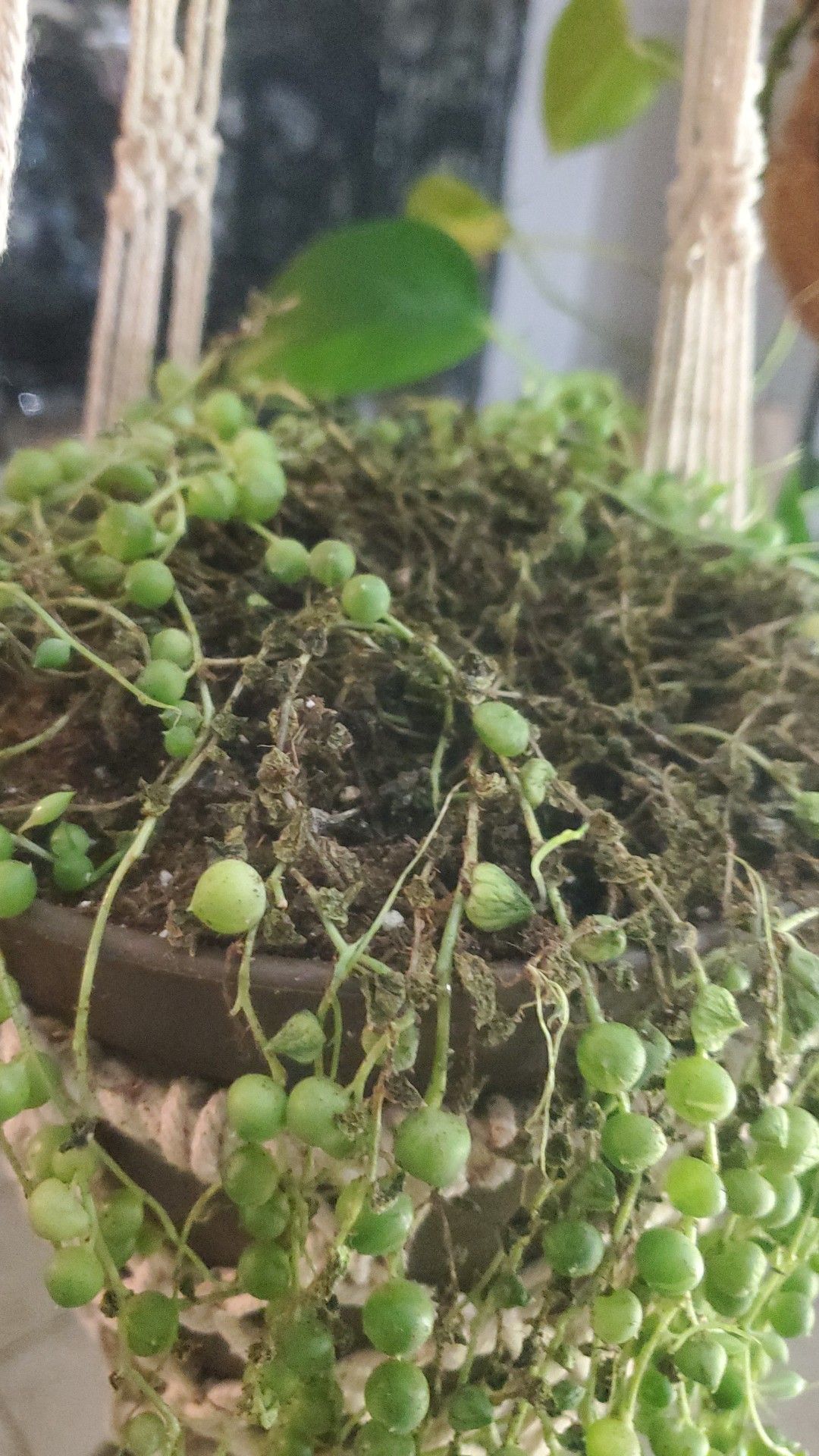
String of Pearls (Senecio rowleyanus) is a stunning trailing succulent known for its unique bead-like leaves that gracefully cascade over pots and hanging baskets. This plant not only adds an exotic charm to your indoor or outdoor garden but is also relatively low-maintenance when provided with the right conditions.
However, despite its resilience, it is susceptible to environmental stressors, improper care, and neglect. If your once-lush plant has started to shrivel, turn yellow, or lose its pearls, don’t worry! The good news is that it is possible to revive your String of Pearls and restore its natural beauty with the proper care and attention.
In this comprehensive guide, we’ll explore the common causes of decline and provide step-by-step solutions to help bring your plant back to life. Whether the issue is overwatering, poor lighting, or pest infestations, we’ll cover everything you need to know to ensure your plant thrives again.
I’ve provided detailed information in the article below to help with your concerns, However, if you still have questions or need more help, feel free to share photos of your plants or describe your issue on our Facebook Group. Just join the group and leave a comment on the most recent post — either I or someone from the community will respond as soon as possible. We also share helpful and unique plant care tips daily, so consider joining the group to stay updated!
Understanding the Problem: Why Is Your String of Pearls Dying?

It’s crucial to identify what’s causing your plant’s decline. Several factors can contribute to a struggling String of Pearls, and diagnosing the root cause is the first step toward effective treatment.
1. Overwatering
Overwatering is one of the most common reasons for a dying String of Pearls. Unlike traditional houseplants, succulents like this one store water in their fleshy leaves, meaning they require less frequent watering. Excess moisture leads to root rot, which can rapidly kill the plant if left unchecked.
- Symptoms of Overwatering:
- Pearls turning yellow or mushy
- Stems becoming soft or blackened
- A foul smell coming from the soil
- Persistent dampness in the potting mix
- Solution:
- Remove the plant from its pot and inspect the roots.
- Trim off any black or mushy roots using sterilized scissors.
- Allow the plant to air-dry for a few hours before repotting.
- Repot in a well-draining succulent or cactus soil mix.
- Adjust your watering schedule—only water when the soil is completely dry.
2. Underwatering
While succulents are drought-tolerant, they still require a moderate amount of water to thrive. If your String of Pearls is not receiving enough moisture, the pearls will begin to shrivel and dry out.
- Symptoms of Underwatering:
- Pearls appearing wrinkled and deflated
- Soil pulling away from the sides of the pot
- Dry, brittle stems
- Solution:
- Increase the frequency of watering, but avoid overcompensating.
- Use the ‘soak and dry’ method: water thoroughly, then let the soil dry completely before watering again.
- If severely dehydrated, mist the plant lightly to provide gradual hydration.
3. Improper Lighting
String of Pearls thrives in bright, indirect sunlight. Insufficient light can cause leggy, weak growth, while excessive direct sunlight can scorch the leaves.
- Symptoms of Improper Lighting:
- Stretched-out, elongated stems with sparse pearls (too little light)
- Bleached, crispy pearls with brown spots (too much direct sunlight)
- Solution:
- Place your plant near a bright window that receives indirect sunlight.
- If indoors, an east or south-facing window is ideal.
- Use sheer curtains to filter harsh afternoon sun if growing outdoors.
- Consider using a grow light if natural light is insufficient.
4. Poor Soil Drainage
String of Pearls requires well-draining soil to prevent excess moisture from accumulating around the roots.
- Symptoms of Poor Drainage:
- Soil remains wet for long periods after watering
- Slow growth or no new growth
- Increased susceptibility to fungal infections
- Solution:
- Use a succulent or cactus potting mix with added perlite, pumice, or sand.
- Ensure your pot has drainage holes to allow excess water to escape.
- Avoid using dense or moisture-retentive soils like regular potting soil.
5. Pests and Diseases
Pests and fungal infections can weaken and damage your plant, leading to poor health and deterioration.
- Common Pests: Mealybugs, spider mites, aphids
- Common Diseases: Root rot, fungal leaf spots
- Symptoms of Pests and Diseases:
- Sticky residue on leaves
- Webbing or cotton-like masses on stems
- Black or brown spots on pearls
- Solution:
- Inspect the plant regularly and remove visible pests manually.
- Use neem oil or insecticidal soap to treat infestations.
- Prune affected areas and apply a fungicide if a fungal infection is present.
6. Temperature and Humidity Issues
Extreme temperatures and humidity levels can stress the plant, causing drooping and discoloration.
- Ideal Temperature Range: 65°F–80°F (18°C–27°C)
- Avoid: Placing near heating vents, AC units, or drafty windows.
- Solution:
- Maintain consistent temperatures and moderate humidity levels.
- Keep the plant in a stable environment, away from sudden temperature changes.
Step-by-Step Guide to Reviving Your String of Pearls
Now that we’ve identified the common problems, let’s go through a detailed plan to restore your plant’s health.
1. Adjust Watering Habits
- Stick to a balanced watering schedule based on your plant’s needs.
- Use a moisture meter or check the top inch of soil before watering.
2. Provide Optimal Lighting
- Ensure your plant receives 6 hours of bright, indirect sunlight daily.
- Supplement with a grow light if natural light is limited.
3. Improve Soil and Drainage
- Repot using well-draining soil and a pot with drainage holes.
- Add perlite or sand to improve aeration and drainage.
4. Address Pests and Diseases
- Regularly inspect your plant and treat pests promptly.
- Maintain cleanliness around your plant to prevent infestations.
5. Prune and Propagate
- Remove dead or damaged strands to encourage new growth.
- Propagate healthy cuttings to create a fuller plant.
Preventing Future Problems: Long-Term Care Tips
- Stick to a Proper Watering Routine – Avoid overwatering and underwatering.
- Maintain Good Lighting – Rotate the plant to ensure even exposure.
- Use Fertilizer Sparingly – Feed with diluted succulent fertilizer in spring and summer.
- Monitor for Pests – Regularly check for signs of infestations.
- Repot When Necessary – Refresh soil every few years to maintain plant health.
